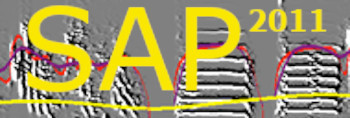Introduction to similarity measurements
| < PREVIOUS: Chapter 10 Contents___________________________________________ | > NEXT: The metric system |
|
|
|
The similarity measurements implement the same feature-based metrics of Euclidean distances used for the cluster analysis, except that here we do not look across thousands of syllables, but rather at the time course of feature values across two specific sounds. Similarity measurements should not be used for comparing simple sounds (such as two tones), in such cases, differences across mean and range of features is preferred. Similarity measurements are necessary for comparing two complex sounds, e.g., a pair of songs or several pairs of complex syllables. AlthoughSAP2011 segments sounds to syllables, this segmentation is not used as a unit of similarity analysis, that is, we compare everything to everything in the two sounds regardless of syllable structure.

Limitation: Similarity measures must be tuned to each species. The current version is tuned to zebra finches. SAP2011 makes it very easy to set and save feature scales to other species. Setting the feature scale for a new species is easy. First, set all the sliders to the new position and then click 'save new scale' and type the new species name. You can then browse between the settings by clicking the up and down arrowheads. Note that SAP2011 will always start with the default setting (zebra finch) and you should remember to set it each time to the appropriate species.
The aim of analysis is to address three issues:
- · Assessing the likelihood that two sounds are related to each other.
- · Quantifying the accuracy of the vocal match (assuming that sounds are related).
- · Accounting for the temporal order (syntax) of sounds when scoring similarity.
Similarity measurements in SAP2011 are quite different than those used in previous versions of Sound Analysis:
- · Similarity measurements are more accurate and more transparent to the user.
- · Both symmetric and asymmetric similarity measurements methods are implemented.
- · Partial similarity scores are shown for each syllable.
- · Users can open two long recording sessions (of a few minutes each) and perform partial. similarities much more efficiently without draining memory.
- · New features include amplitude modulation (AM) and goodness of pitch. We eliminated the spectral continuity feature
- · Automated batching provides a link between cluster analysis and similarity measurements, allowing a fully automated measurement of thousands of sounds, which are automatically opened, outlined and scored.
- · The memory management scheme has been altered to reduce memory allocation error and optimize the section detection.
